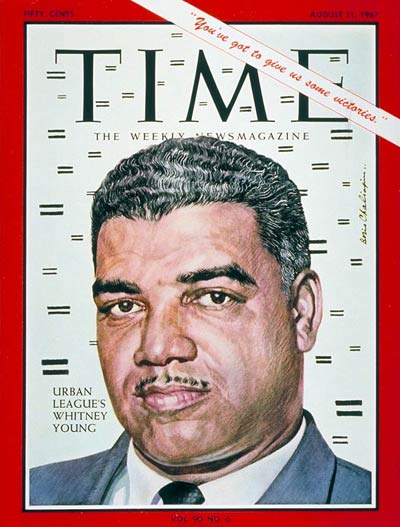Legacy in Action: What Whitney Young’s Vision Means for the Urban League Today

Photo Credit: TIME Magazine, August 23, 1963.
In August 1963, the face of Whitney M. Young Jr. appeared on the cover of TIME magazine. At the time, he was the Executive Director of the National Urban League, and his appearance signaled something bigger than national recognition. It told the country that the fight for civil rights and the power of strategic advocacy could no longer be ignored.
This moment came just days before the March on Washington, where Dr. Martin Luther King Jr. delivered his “I Have a Dream” speech. While Young wasn’t the loudest voice on the national stage, he was one of its strongest. Behind the scenes, he was building powerful relationships and pushing for real change that would impact lives across the country.
A Leader with a Plan
When Whitney Young took leadership of the National Urban League in 1961, he shifted its focus from quiet service work to bold advocacy. He knew that helping people wasn’t enough if the systems holding them back didn’t change. Young believed in working within institutions to transform them. His approach was strategic. He didn’t just raise his voice, he got to the table.
And that table included the highest levels of power.
Young advised President John F. Kennedy, encouraging his support for the March on Washington. He worked closely with President Lyndon B. Johnson, helping shape key parts of the administration’s War on Poverty, including programs that came directly from Young’s own “Domestic Marshall Plan” for urban communities. He also advised President Richard Nixon, whose administration increased support for programs that served Black communities. Nixon once said, “Whitney Young’s genius was that he knew how to accomplish what other people were merely for.”
Building Opportunities That Last
Under Young’s leadership, the Urban League launched major initiatives that left a lasting mark. He helped create the Street Academy, an alternative education program designed to get high school dropouts into college. He also led the New Thrust program, which supported local Black leaders working to solve problems in their own communities.
He used the Urban League’s influence to push for fair housing, better schools, and real jobs for Black Americans. He opened doors in boardrooms, influenced federal policy, and built partnerships that helped Black workers gain access to industries that had long shut them out.
Young’s message, featured in bold on the TIME magazine cover, said: “You’ve got to give us some victories.” It was a reminder that speeches and marches weren’t enough. People needed jobs, homes, and dignity.
What It Means Today
For the Urban League of Hampton Roads and affiliates across the country, Whitney M. Young Jr.’s legacy lives on. His work laid the foundation for what we do today, whether it’s preparing someone for a job interview, supporting a first-time homebuyer, offering wellness services, or advocating for systemic change.
Young showed that leadership can look like strategy, persistence, and relationships built on respect. He reminded the nation that progress happens when we come together, when we offer not just hope, but opportunity.
Want to learn more? Check out the video below from Documentary Central about Whitney Young.
Carrying the Legacy Forward
The Urban League of Hampton Roads is proud to continue the work started by Whitney M. Young Jr. We believe in building strong, inclusive communities through education, employment, housing, health, and advocacy. You can drive the Movement forward, too.
